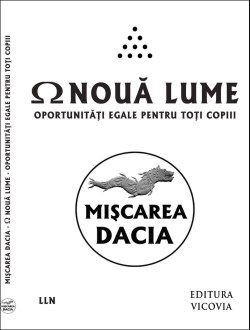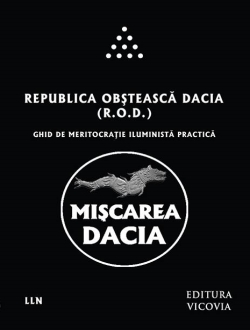 Vă invit să vă alăturaţi grupului Facebook Mişcarea DACIA, ce-şi propune un alt fel de a face politică!
Vă invit să vă alăturaţi grupului Facebook Mişcarea DACIA, ce-şi propune un alt fel de a face politică!Citiţi partea introductivă şi proiectul de Program, iar dacă vă place, veniţi cu noi !
O puteţi face clicând alături imaginea, sau acest link
Archive for the ‘Mişcarea Dacia’ Category:
Muzica Stelelor
Helena De Brabander a distribuit un link în grupul Hyperianism – The Outer Circle (Activism and Optimization).
1 oră ·
“It’s time to understand the code, the code of life. Life is not what you think it is. Life is identical to light. That explains why the ancients worshiped the sun … the source of light and life. You cannot have life without light.
A “soul” – a massless, unextended, dimensionless, immaterial entity outside space and time – is a light being … a being made of photons. But the great secret of light is that it is the most rational thing you can get. Light, when properly understood, is nothing other than ontological mathematics, i.e. mathematics exists in the universe as light, and everything comes from light (from mathematics).
Light is the fiber and fabric of existence, which is to say that mathematics is what existence is. Mathematics is light itself, life itself, mind itself, and thought itself. And matter is simply “broken” light. There is nothing other than light = mathematics.”
“The most intelligent people – the geniuses – are able to take conceptual leaps that defy the understanding of ordinary people. You are extraordinarily intelligent if you can conceive that thoughts are photons, that suns pour out the thoughts of the Cosmic Mind into spacetime and matter, and that black holes restore spacetime thoughts to their Singularity origin.
Given that minds think, then, to say that photons are thoughts, is equivalent to saying that minds are made of light, that minds comprise autonomous, complete and consistent collections of photons. Given that all minds are alive (there are dead, or “undead”, bodies, but no such things as dead minds) then photons are not only thoughts, they are also the basic ingredients of life. Suns are the central, controlling lives of solar systems, and they produce the conditions for plant and animal life to appear on planets such as Earth. They are the solar Gods that project life into their solar domain.
The Singularity is the immaterial source of life and mind, outside space and time. It emanates material suns (solar holograms) that convey life and mind into the spacetime universe of matter. Moons and planets are the detritus of previous generations of suns. On planets, the light (life, thoughts) of suns produces bodies that can be controlled by individual souls.
The carbon, nitrogen and oxygen atoms in our bodies were created in old, long dead stars. The lighter elements come from small exploding stars (novae), while the heavier elements come from large exploding stars (supernovae). Stellar explosions throw out vast clouds of dust and gas, and this material from the exploded stars disperses throughout interstellar space where it can combine into moons, planets or new stars.
What do stars do? They fuse simple hydrogen nuclei to create more complex nuclei, and thus the material world, full of all the elements, comes into being.”
I came across this video, is the truth about stars being deliberately held back?
THE STARS SING: (don’t mind the religious take, the sound frequencies and images are very interesting)
Tags: Energie, Fotoni, Frecvenţă, Gânduri, Lumină, Lumină Frântă, Lumină Pură, Minte, muzica, Soare, Spaţiu-Timp, Stele, Sunet, unda, Venus
Hyperian History Of The World (1st Century)
“Hyperian History Of The World (1st Century)
As the Roman Empire spread in the 1st Century, much of the Mediterranean world was conquered, including the former Greek, Hellenic lands. These lands fell under Roman law, yet still mainly subscribed to Greek culture. One area, however, had a drastically different culture, one which would cause great strife in the world. The land in question was Palestine, which had formerly been the ‘promised land’ of the Jewish people.
Despite the former kingdoms of Israel having been destroyed centuries earlier, and the Jews carried off into exile, they had been allowed to return to their land and their zealous monotheism, greatly at odds with most of the surrounding cultures, had only increased in intensity. In the time since the fall of Israel, the Jews had finalised all of their holy texts and compiled what we now call the Old Testament. The bulk of this text consists of an idealised account of the history of the Jewish people and their covenant with their god, but the books towards the end, more recently written, were of a more prophetic nature and spoke of the coming of the ‘Messiah’, a great king of the Davidic line who would restore the kingdom of Israel.
Under the Roman occupation of the 1st Century, the Jews in this land had splintered into many competing sects and it was very common for charismatic figures to rise from these sects, claim to be the Messiah and attempt to drive out the Romans in order to restore the Davidic kingdom. However, all such attempts failed as a rabble of religious fanatics were never a match for the might and discipline of the Roman army. However, one particular Jewish ‘Messiah’ would go on to become one of the most influential figures in the history of religion, despite his failure to restore the Kingdom of Israel.
This figure has become known as Jesus Christ, yet it is very difficult to decipher any truth about his life. It seems that he was yet another charismatic Jew who rose up amongst his people, claimed to be the Messiah and attempted to take on the might of Rome. Of course, he failed and was put to death. Yet, somehow, his devoted followers, despite his failure, became convinced that he was the Messiah, and that he had, in fact, risen from the dead and ascended into heaven following his crucifixion by the Romans.
Initially, this new sect, which became known as Christianity, was just another Jewish sect among the many in Palestine, yet this one grew and spread all around the Hellenic world in the decades following Jesus’s death. The growth and spread of Christianity, however, has little to do with Jesus and much more to do with one Saul of Tarsus, later known as Saint Paul.
Initially, Christianity, as just another Jewish sect, spread mostly around the Jews, and came under attack from rival sects. Saul of Tarsus was, initially, one who persecuted this latest sect. However, he eventually converted to this new form of Judaism and came up with the key idea of spreading its teachings amongst non-Jews, or Gentiles.
Now calling himself Paul, he knew that Gentiles were unlikely to respond to Jewish Messianism, as it had nothing to do with their pagan culture, yet Paul’s knowledge of that culture helped him to formulate a new version of Christianity, more distanced from Judaism and closer to Greek/Roman paganism.
Given that all the other Jewish sects denied that Jesus had been the Messiah, Paul realised that he needed to find a way to include the Gentiles in the Covenant with the Jewish god. Paul began spreading the message that Jesus had been sent to the Gentiles precisely because the Jews had rejected him. Paul convinced Gentiles that they could be part of the Covenant by telling them that Jesus’s death and resurrection had been for the sake of all the faithful, and that being baptised and having faith in Jesus would suffice to include them in the covenant, without them having to subscribe to Jewish religious laws such as Circumcision, which Paul knew pagans found repulsive. According to Paul, baptism allowed anyone to ‘participate’ in Jesus’s death and resurrection. Thus, Paul managed to remove much of Judaism from Christianity and make it much more palatable to pagans.
Following Paul’s innovations, Christianity began to split further and further away from Judaism. Meanwhile, the Jews were still giving the Romans trouble in Palestine, leading to the destruction of Jerusalem in the year 70. Following this the Jews were once again forced into exile, dispersing all across the land. Christians too dispersed and settled separately from the other Jews until, in the year 98, Christians were exempted from the Roman tax on Jews, thus confirming them as a completely Gentile sect distinct from any kind of Judaism.
Eventually, the establishment of Christianity as a new, Gentile religion would have disastrous effects on the Roman Empire and the glory of Ancient Greek culture. It would take a few centuries, but the appearance of this new religion would lead to a time of great darkness in the world, one from which we still have not entirely emerged.”
Brice Merci – Hyperian

Tags: Christianity, Gentiles, Hyperians, Jesus Christ, Judaism, Messianism, Paul, Roman Empire, Saul of Tarsus
Videoconferinţa Mişcării Dacia din 22.05.2019
Tags: Dumnezeu
Universul Dimensional cu 6 Dimensiuni
“Timpul și Spațiul sunt o iluzie numai în sensul că, în mod obiectiv, ele sunt pur și simplu Funcții Matematice pe care le Interpretăm în acest mod.
Prezentul este foarte real, suntem aici în acest moment, Trecutul este plecat pentru totdeauna, iar Viitorul este încă de venit. Realitatea este creată instantaneu, de Minte. Nici măcar „Dumnezeu” nu poate cunoaște Viitorul cu o precizie absolută, pentru că Viitorul va fi decis de toate deciziile pe care le va lua fiecare Minte Individuală.
Ideea că timpul este o Iluzie duce numai la Nihilism, pentru că sfârșeşti prin a gândi că nu există Timp. Timpul este de fapt „Spațiu Imaginar” (rezultat din cele trei dimensiuni Imaginare, și la fel ca şi în Spațiu, tu ai şi o locație în Timp. Această locație este numită Acum, iar Acum este tot ceea ce Există, Trecutul este locația de Acum-uri care s-au întâmplat înainte. Aici vedem că acel timp și ordinea evenimentelor sunt de fapt lucruri separate. Viitorul este doar locația de Acum-uri ce urmează după locația actuală a Acum-ului. Timpul este o coordonată care, de fapt, este adăugată Spațiului, iar Suma este întotdeauna Viteza Luminii.
Acesta este motivul pentru care atunci când mergeți mai repede timpul merge mai încet. Aceste neînțelegeri provin din lipsa de a vizualiza Timpul ca parte a Universului cu șase dimensiuni. Ceea ce experimentăm ca ordonare a evenimentelor este de fapt memoria stărilor trecute, care sunt înmagazinate în Monada Individuală în afara Spațiului și Timpului.
Tot ce există este Acum. Astfel, semnalele tuturor Monadelor Individuale (adică noi) formează circumstanțele care se dezvoltă în viitor. Deci, fiecare dintre noi se auto-determină, prin introducerea propriilor semnale în Acum-ul care se mișcă mereu. Deci suntem cu toții determinaţi de noi înşine, problema este că, atunci când toată lumea se auto-determină, toate aceste semnale se ciocnesc și conflictele creează această lume a Liberului Arbitru.”- Hyperians

Tags: „Acum”, Hyperians, Liberul Arbitru, Monade, Prezent, Spaţiu, Timp, Trecut, Univers cu 6 dimensiuni, Viitor
Videoconferinţa Mişcării Dacia din 15.05.2019
Tags: Şcientism











